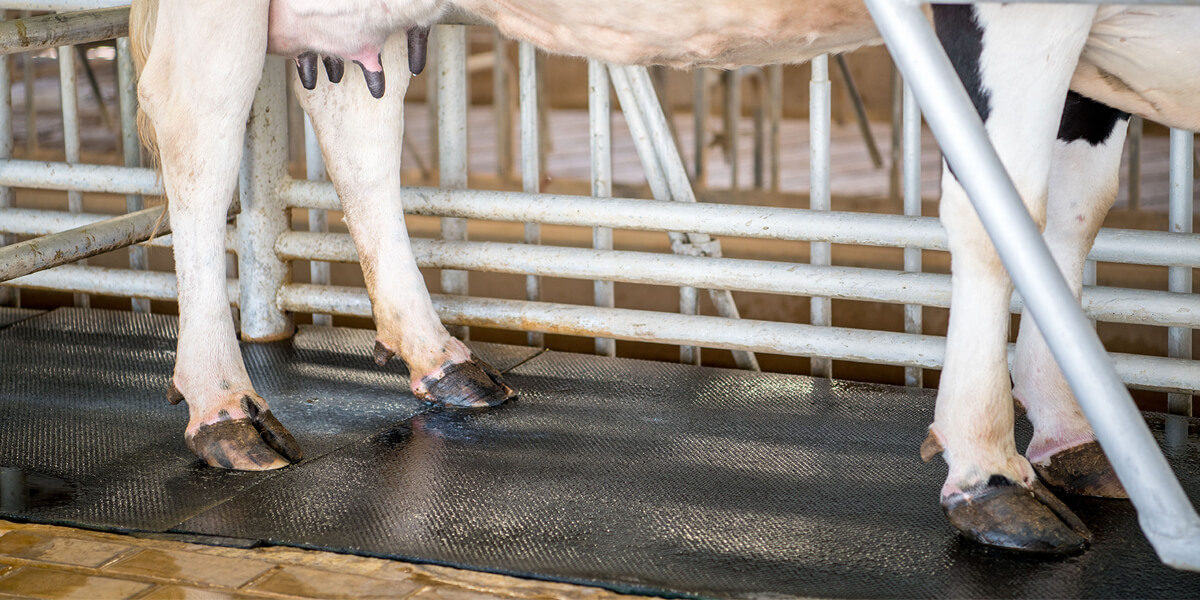Good hoof health records are key to monitoring cow hoof problems and for developing control and preventative measures. This can help dairy producers prevent lameness as well as prevent a drop in performance often caused by dairy cow lameness.
The costs of treatment for each case of lameness comes with an estimated cost of between $100 and $300. And it is not uncommon to see lameness prevalence above 20 – 30% or, in some cases, even well above 50% in a dairy herd.
Hoof health records allow dairy producers to evaluate the impact of dairy cow lameness on their profits, establish new control and prevention programs and monitor current practices to manage and prevent lameness.
How Hoof Health Records Help Prevent and Manage Cow Hoof Problems
Hoof health records allow dairy producers to evaluate whether or not the hoof health on their operation is in line with the industry standards for their production system and their peers. If not, they can take corrective measures and keep using hoof health records to assess their interventions.
Some examples of actions, based on a review of hoof health records, that can be taken if a dairy producer finds a dairy cow lameness problem in their operation include:
- Increasing the frequency of footbaths if there is a variation on the baseline infectious lameness problem.
- Making structural and design changes to the facilities to increase cow comfort when non-infectious problems show an elevated incidence.
- Establishing a program for regular hoof trimming and evaluating compliance with the program.
- Improving dairy cow nutrition with Zinpro Performance Minerals® and using records to track the added benefits associated with the change.
Why Dairy Producers Aren’t Keeping Hoof Health Records
Hoof health is, in many cases, not systematically recorded like other diseases like mastitis or somatic cell counts, which are checked every day during milking. In many cases, hoof health is only recorded based on professional hoof trimmer visits to the dairy operation, which can be as seldom as once per month.
Another reason why hoof health records are lacking on dairy operations is that there is not an automatic method for checking hoof or locomotion condition. Dairy producers and employees need to physically look at the gait or each cow individually or their feet in order to record any lesions and locomotion score. Moving cattle into chutes to check their feet and administering a treatment if there are cow hoof problems can utilize employee time and disturbs the natural flow of the operation.
Dairy producers may also not keep hoof health records of cows with mild lameness cases given that specific control or treatment measures are unfortunately not taken at this stage of the disease.
Additionally, dairy producers are often not fully aware of the hidden losses their operation may be suffering due to the impact dairy cow lameness can have on growth, reproduction and milk production, therefore keeping records might appear to have a low priority. For example, a cow experiencing mild lameness might make producers think that treatment is not necessary, but it could ultimately be the reason she doesn’t get pregnant during this lactation. Or this mild lameness case could be pulling immune resources away from the mammary gland, resulting in secondary infections that increase somatic cell count or favor the occurrence of mastitis.
By decreasing lameness and improving hoof health, dairy producers can mitigate problems in their dairy operations, and it can be easily achieved by keeping good hoof health records and acting on the records.
How to Develop Good Hoof Health Records
Ideally, dairy producers should be checking and recording hoof health daily. Larger farms can even hire employees who are partially dedicated to this task. Dairy producers should be recording locomotion scores, lesion scores and monitoring activity levels tracked by automatic pedometers.
When recording hoof health records, keeping procedure standardization is key. The criteria for identifying and recording dairy cow lameness varies not only from farm-to-farm, but in many cases from different operators within the same farm. Many times, records may have inconsistent disease classification that can complicate the interpretation.
An effort should be made to simplify the types of lesions that are recorded. More than 75% of the lesions observed can be summarized by just five diseases: digital dermatitis, white line lesions, sole ulcers, foot rot and toe problems. Farms can simplify and standardize their records relatively easily. The Zinpro Cattle Lameness Book could be an excellent reference when identifying lesions.
Hoof health records must also be reliable. This means consistently and accurately recording any lesions or cow hoof problems you see on a regular basis, without skipping available information. If a professional hoof trimmer is keeping hoof health records, make sure they are sharing the records with the dairy producer so they can be kept with additional operation records as well.
Hoof Health Record Resources
Many commercial farm data storing applications have functionality for keeping various levels of hoof health records. Many independent platforms have been built specifically to enter hoof health records and can eventually synchronize with farm data software. Zinpro has a number of resources that can help you manage hoof health records and use them to evaluate the impact of dairy cow lameness on a dairy operation:
- The FirstStep® Dairy Hoof Health & Management Programs allows users to record locomotion scores or hoof lesions prevalence helping to determine the extra profit potential your herd can achieve by reducing the prevalence of lameness.
- The Cattle Lameness Book is a state-of-the-art summary explaining why and how dairy cow lameness occurs and what can be done to prevent and control it. High-quality photos and dozens of original illustrations and schematics are also used to make comprehension easy and fun.
To learn more about the resources Zinpro provides for keeping hoof health records on your dairy operation, contact a Zinpro representative today. Visit us online to learn more about the FirstStep Program.

